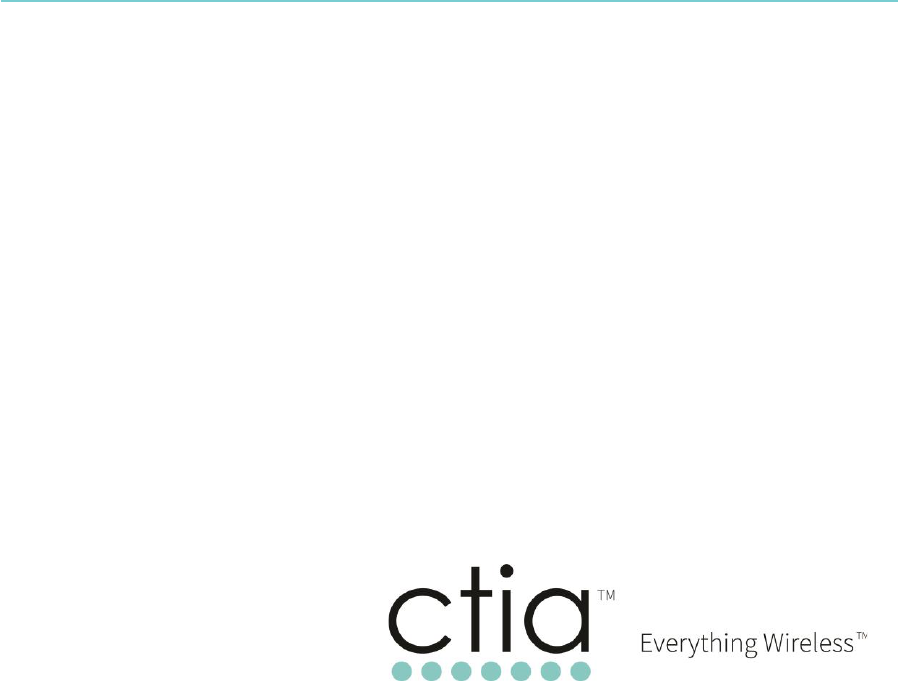
Messaging Principles and Best Practices
May 2023

Messaging Principles and Best Practices MAY 2023
2
Table of Contents
1 EXECUTIVE SUMMARY 1
2 SCOPE 2
2.1 Purpose 2
2.2 Wireless Messaging Services 2
2.3 Scope, Limitations, & Disclaimer of Legal Guidance or Advice 3
3 WIRELESS MESSAGING ECOSYSTEM 4
3.1 Background 4
3.2 The Evolving Wireless Messaging Ecosystem 4
3.3 Messaging Ecosystem Roles 5
3.3.1 CONSUMER 5
3.3.2 NON-CONSUMER 5
3.3.3 WIRELESS FACILITIES-BASED SERVICE PROVIDERS (WIRELESS PROVIDERS) 5
3.3.4 MOBILE VIRTUAL NETWORK OPERATORS (MVNOS) 5
3.3.5 CLOUD-BASED PROVIDERS 6
3.3.6 INTER-CARRIER VENDORS (ICVS) 6
3.3.7 CONNECTION AGGREGATORS 6
3.3.8 COMPETITIVE LOCAL EXCHANGE CARRIERS (CLECS) 6
3.3.9 REGISTRARS 6
3.3.10 NETWORK SECURITY VENDORS 6
3.3.11 SERVICE PROVIDERS 6
3.3.12 MESSAGE SENDER OR SENDER 6
4 CONSUMER / NON-CONSUMER TRAFFIC CLASSIFICATION 8
4.1 Consumer Messaging 8
4.1.1 WHAT IS TYPICAL CONSUMER OPERATION? 8
4.1.2 CONSUMER MESSAGING AUTOMATION 9
4.2 Non-Consumer Messaging 9
5 NON-CONSUMER BEST PRACTICES 10
5.1 Consumer Consent 10
5.1.1 MESSAGE SENDERS SHOULD PROVIDE CLEAR AND CONSPICUOUS CALLS-TO-
ACTION 11
5.1.2 CONSUMER OPT-IN 11
5.1.2.1 Confirm Opt-In for Recurring Messages 12
5.1.2.2 Apply One Opt-In per Campaign 13
5.1.3 CONSUMER OPT-OUT 13
5.1.4 RENTING, SELLING, OR SHARING OPT-IN LISTS 13
5.1.5 MAINTAIN AND UPDATE CONSUMER INFORMATION 13
5.2 Privacy and Security 14

Messaging Principles and Best Practices MAY 2023
3
5.2.1 MAINTAIN AND CONSPICUOUSLY DISPLAY A CLEAR, EASY-TO-UNDERSTAND
PRIVACY POLICY 14
5.2.2 IMPLEMENT REASONABLE PHYSICAL, ADMINISTRATIVE, AND TECHNICAL SECURITY
CONTROLS TO PROTECT AND SECURE CONSUMER INFORMATION 14
5.2.3 CONDUCT REGULAR SECURITY AUDITS 14
5.3 Content 14
5.3.1 PREVENTION OF UNLAWFUL ACTIVITIES OR DECEPTIVE, FRAUDULENT, UNWANTED, OR
ILLICIT CONTENT 14
5.3.2 EMBEDDED WEBSITE LINKS 15
5.3.3 EMBEDDED PHONE NUMBERS 15
5.4 Text-Enabling a Telephone Number for Non-Consumer Messaging 15
5.5 Other Non-Consumer Message Best Practices 15
5.5.1 SHARED TELEPHONE NUMBERS AND SHORT CODES 15
5.5.2 SNOWSHOE MESSAGING 15
5.5.3 GREY ROUTES 16
5.5.4 COMMON SHORT CODES 16
5.5.5 PROXY NUMBERS 16
5.5.6 TEXT-ENABLED TOLL-FREE TELEPHONE NUMBERS 17
5.5.6.1 Authority to Text-Enable Rests with the Toll-Free Voice
Subscriber 17
5.5.6.2 Transparency to Resp Orgs 17
5.5.6.3 Special Considerations for Shared-Use Toll-Free Telephone
Numbers 17
6 SPECIAL USE CASES 19
6.1 Group Messaging 19
6.2 Spoofing Telephone Numbers 19
6.3 Registries 19
7 UNWANTED MESSAGING TRAFFIC THREAT CONTAINMENT 20
7.1 Core Principles 20
7.2 Unwanted Messaging Traffic Containment Best Practices 20
7.2.1.1 Consumer Tools for Blocking or Filtering 20
7.2.1.2 Reporting Unwanted Messaging Traffic 21
7.2.2 COMMUNICATION AMONG SERVICE PROVIDERS 21
7.2.3 BLOCKING UNWANTED MESSAGES AND SENDERS 21
7.2.4 SUSPENDING AND DISCONNECTING UNWANTED MESSAGING TRAFFIC 21
7.2.5 TRANSPARENCY OF TRAFFIC 21
7.2.6 MITIGATING UNWANTED MESSAGE ISSUES 21
7.2.7 NETWORK OPERATIONS CENTER 21

Messaging Principles and Best Practices MAY 2023
Page 1 of 22
1 Executive Summary
The Messaging Principles and Best Practices (Principles and Best Practices) are a set of
voluntary best practices developed by CTIA’s member companies throughout the
wireless messaging ecosystem.
Messaging’s popularity is largely attributable to its status as a trusted and convenient
communications environment. These Principles and Best Practices are intended to
reflect the wireless industry’s efforts to preserve the trust in and utility of Wireless
Providers’ messaging services and help protect Consumers from Unwanted Messages.
They identify parameters for facilitating the exchange via transmission, storage, and
retrieval (exchange) of messages via Wireless Provider messaging networks.
Throughout these Principles and Best Practices, messages are categorized as either
Consumer or Non-Consumer messaging depending on the Message Sender. The prior
version of these Principles and Best Practices used the terms “Consumer (P2P)” and
“Non-Consumer (A2P).” Some Wireless Providers may still use the legacy terms as part
of their efforts to support a trusted messaging environment. The current definitions for
Consumer and Non-Consumer are included in Section 3.3.
As explained in the definitions for these terms in Section 3.3, if the Message Sender is a
business, organization, or other entity – or an agent, representative, or other individual
acting on behalf of a business, organization, or other entity – the messaging is
considered Non-Consumer. There are specific Principles and Best Practices that apply
to Consumer messaging and others that apply to Non-Consumer messaging (e.g., Non-
Consumers are expected to obtain a Consumer’s consent before sending them
messages).
The objectives of this document are to support a robust and dynamic wireless
messaging community where:
• Consumers can exchange wanted messages with other Consumers;
• Message Senders and Consumers can exchange wanted messages; and
• Consumers are protected from Unwanted Messages, in conformity with
applicable laws and regulations, such as the United States’ Telephone
Consumer Protection Act (TCPA) and the Controlling the Assault of Non-
Solicited Pornography and Marketing Act of 2003 (CAN-SPAM Act).

Messaging Principles and Best Practices MAY 2023
Page 2 of 22
2 Scope
2.1 Purpose
The Principles and Best Practices are intended primarily for entities operating in the
wireless messaging ecosystem to facilitate innovation and the use of wireless messaging
while protecting Consumers from Unwanted Messages. The Principles and Best
Practices may also help inform Consumers about wireless messaging services and
anyone with an interest in the wireless messaging ecosystem.
These Principles and Best Practices represent an important further step in the wireless
industry’s effort to support new uses and business opportunities in wireless messaging
services while maintaining protections for Consumers from Unwanted Messages. In
particular, these Principles and Best Practices are intended to demonstrate Wireless
Providers’ efforts to balance the exchange of messaging traffic for, among other
reasons, public interest purposes – including for example political, educational,
emergency, and non-profit purposes – while continuing to protect Consumers from
Unwanted Messages. By establishing clear parameters and guidelines, these Principles
and Best Practices encourage Message Senders to maintain Consumer trust and
confidence in Consumer services and support the adoption of innovative Non-
Consumer services.
This version of the Principles and Best Practices replaces the 2019 CTIA Messaging
Principles and Best Practices in order to further clarify expectations among wireless
messaging ecosystem stakeholders for identifying Consumer and Non-Consumer
messaging (as defined in Section 3.3) and establish clear guidelines for Non-Consumer
messages.
Although the specific technical and operational details required for Service Provider
implementation are beyond the scope of this document, the Principles and Best
Practices acknowledge that Service Provider implementation will be an ongoing and
iterative process that continues to evolve as new use cases arise. These Principles and
Best Practices are meant to supplement, and not replace, CTIA’s Common Short Code
Monitoring Handbook.
In addition to these Principles and Best Practices, Non-Consumers should consult CTIA’s
Messaging Security Best Practices, which describe security-related best practices that
Message Senders, Service Providers, and other entities participating in the wireless
messaging ecosystem may use to address common threat vectors that can undermine
Consumers’ trust in the wireless messaging ecosystem.
2.2 Wireless Messaging Services
The Principles and Best Practices primarily address wireless messaging services that use
10-digit telephone numbers assigned from the NANP as the unique identifier for the
sender and/or recipient(s) of individual or group messages. Generally, wireless

Messaging Principles and Best Practices MAY 2023
Page 3 of 22
messages are exchanged between 10-digit NANP telephone numbers via Wireless
Providers’ messaging networks. These messaging services include:
• Short Message Service (SMS);
• Multimedia Messaging Service (MMS); and
• Rich Communications Services (RCS).
As described in Section 5.5 below, a five- or six-digit number known as a short code can
also be used to exchange wireless messages via Wireless Providers’ messaging
networks. While these Principles and Best Practices should be interpreted consistent
with CTIA’s Common Short Code Monitoring Handbook, Message Senders that use a
common short code (CSC) should adhere to the terms of those services as described in
the Common Short Code Monitoring Handbook and individual wireless providers’ terms
of use.
The messaging ecosystem also includes cloud-based services that require the use of a
separate messaging client (e.g., an app) that is distinct from and does not interoperate
with Wireless Providers’ messaging networks. These Principles and Best Practices are
intended to apply to messaging services that only interoperate between cloud-based
platforms and Wireless Providers’ messaging networks using the applicable services,
such as SMS, MMS, or RCS.
2.3 Scope, Limitations, & Disclaimer of Legal Guidance or Advice
CTIA’s Principles and Best Practices do not constitute or convey legal advice and
should not be used as a substitute for obtaining legal advice from qualified counsel.
Use of and access to the Principles and Best Practices or any of the links contained
herein do not create an attorney-client relationship with CTIA and the user.
Messaging services may be subject to a number of legal requirements, including for
example those established under the TCPA; the CAN-SPAM Act; the Communications
Act of 1934, as amended; the Federal Trade Commission Act; and implementing
regulations and decisions adopted by the Federal Communications Commission and
Federal Trade Commission.
1
Anyone using these Principles and Best Practices should
consider obtaining legal and regulatory advice prior to taking any action related to the
use of messaging services.
As a set of voluntary best practices, CTIA’s Principles and Best Practices do not impose,
prescribe, or require contractual or technical implementation on messaging ecosystem
stakeholders, including Service Providers. Due to contractual, technical, or other
practical factors, methods of implementing the Principles and Best Practices may vary
among stakeholders. Stakeholders may choose to implement modified and additional
requirements through their individual guidelines, policies, and contracts.
1
See, e.g., FCC, Petitions for Declaratory Ruling on Regulatory Status of Wireless Messaging
Service, Declaratory Ruling, 33 FCC Rcd 12075 (2018); FCC, Text-Enabled Toll Free Numbers,
Declaratory Ruling and Notice of Proposed Rulemaking, 33 FCC Rcd 2438 (2018).

Messaging Principles and Best Practices MAY 2023
Page 4 of 22
3 Wireless Messaging Ecosystem
3.1 Background
In the late 1990s, wireless text messaging evolved to include two-way Consumer-to-
Consumer traffic using 10-digit NANP telephone numbers. Wireless Providers’ messaging
systems were not interoperable – a subscriber could only communicate with other
subscribers of the same Wireless Provider. In the early 2000s, CTIA established the SMS
Interoperability Guidelines, which provided industry standards for SMS interoperation
among mobile networks. Today, wireless messaging services have become a
convenient and trusted communication tool for Consumers and, increasingly, enterprise
users.
In the early 2000s, CTIA and other messaging ecosystem stakeholders developed the
short code platform (i.e., five- or six-digit codes) to enable the appropriate use of bulk
wireless messages (e.g., wireless messaging campaigns). Wireless Providers’
combination of upfront vetting and ongoing auditing allows high-volume messaging
campaigns while minimizing the risk that short codes will be used to distribute Unwanted
Messages.
In 2009 and again in 2011, CTIA and messaging ecosystem stakeholders expanded the
SMS Interoperability Guidelines to guide how non-mobile networks and cloud-based
services could exchange SMS message traffic with mobile wireless networks. In 2014,
CTIA and messaging stakeholders also revised the SMS Interoperability Guidelines to
account for group messaging and text-enabled toll-free telephone numbers. As noted
above, this version of the Principles and Best Practices replaces the 2019 CTIA
Messaging Principles and Best Practices, which also replaced the SMS Interoperability
Guidelines.
These efforts have shared a common goal of maintaining and enhancing a dynamic,
competitive wireless messaging ecosystem while protecting Consumers from Unwanted
Messages.
3.2 The Evolving Wireless Messaging Ecosystem
Messaging to 10-digit NANP telephone numbers has enabled Consumers to
communicate generally with each other and with organizations in a low-volume,
conversational manner. The wireless messaging ecosystem has strived to enable such
low-volume, Consumer-oriented communications while simultaneously seeking to inhibit
Unwanted Messages from reaching Consumers.
Messaging’s popularity among Consumers is largely attributable to its status as a trusted
and convenient wireless communications environment. Messaging is also an
increasingly attractive platform to reach Consumers because of its broad adoption by
Consumers and Consumers’ ability to retrieve messages when convenient and to store
them as desired.

Messaging Principles and Best Practices MAY 2023
Page 5 of 22
In addition to well-established short code services, the Non-Consumer messaging
ecosystem today includes two-way messaging traffic from 10-digit NANP telephone
numbers. This messaging traffic may feature diverse characteristics (e.g., low or high
volumes, balanced or imbalanced ratios of outgoing to incoming messages) and may
serve conversational, informational, or promotional purposes. Regardless of the traffic’s
characteristics or purpose, these advances pose threats to Consumers if Unwanted
Messages negatively impact the role of messaging as a trusted and convenient wireless
communications medium. To protect Consumers from Unwanted Messages, Service
Providers deploy filters and other tools that limit messaging traffic bearing the
characteristics of Unwanted Messages. Section 7 of these Principles and Best Practices
describes some of the principles that messaging ecosystem stakeholders should utilize
to contain Unwanted Messaging traffic.
3.3 Messaging Ecosystem Roles
The messaging ecosystem comprises many stakeholders working together to create,
route, deliver, store, retrieve, and consume messages.
2
3.3.1 Consumer
A Consumer is an individual person who subscribes to specific wireless messaging
services or messaging applications. Consumers do not include agents, representatives,
or any other individuals acting on behalf of Non-Consumers, including businesses,
organizations, political campaigns, or entities that send messages to Consumers.
3.3.2 Non-Consumer
A Non-Consumer is a business, organization, or entity that uses messaging to
communicate with Consumers. Examples include, but are not limited to, large-to-small
businesses, financial institutions, schools, medical practices, customer service entities,
non-profit organizations, and political campaigns. Non-Consumers also include agents,
representatives, or any other individuals acting on behalf of Non-Consumers.
3.3.3 Wireless Facilities-Based Service Providers (Wireless Providers)
Wireless Providers own and operate radio, telephone, and data networks and offer
Consumers a wide variety of wireless communications products and services, including
wireless messaging services such as SMS, MMS, and RCS.
3.3.4 Mobile Virtual Network Operators (MVNOs)
MVNOs are wireless Service Providers that do not own the network infrastructure over
which they provide services. Instead, MVNOs resell network services maintained by one
or more Wireless Providers.
2
As noted above, the prior version of these Principles and Best Practices used the terms
“Consumer (P2P)” and “Non-Consumer (A2P).” Some Wireless Providers may still use the legacy
terms as part of their efforts to support a trusted messaging environment. The current definitions
for Consumer and Non-Consumer are included in Section 3.3.

Messaging Principles and Best Practices MAY 2023
Page 6 of 22
3.3.5 Cloud-Based Providers
Cloud-Based Providers enable services like voice and messaging to end-users using
over-the-top IP connectivity or through interoperability with wireless carrier-networked
services, including wireless messaging. Some Cloud-Based Providers offer an API to
access wireless services, while others offer standalone applications.
3.3.6 Inter-Carrier Vendors (ICVs)
Also called Hub Providers, ICVs act as hubs to facilitate interoperability by transporting
messaging traffic between multiple Wireless Providers and Cloud-Based Providers.
3.3.7 Connection Aggregators
Connection Aggregators offer a variety of value-added services to enterprise
customers, including messaging connectivity with multiple Wireless Providers. Unlike
ICVs, Connection Aggregators do not typically support inter-carrier peering traffic.
3.3.8 Competitive Local Exchange Carriers (CLECs)
In the messaging ecosystem, CLECs provide 10-digit NANP telephone numbers and
traffic routing services to Cloud-Based Providers.
3.3.9 Registrars
Registrars operate databases of telephone numbers and databases of the associated
Communications Provider or Providers enabling wireless messaging service to those 10-
digit NANP telephone numbers (e.g., CLEC, Wireless Provider, Cloud-Based Provider).
The databases establish a record of 10-digit NANP telephone number resources used to
support the effective exchange of wireless messages. Registrars’ customers include
CLECs, Wireless Providers, ICVs, Cloud-Based Providers, and enterprises.
3.3.10 Network Security Vendors
Network Security Vendors provide solutions that enable Wireless Providers, Cloud-Based
Providers, and ICVs to identify Unwanted Messaging traffic. These solutions deliver a
variety of network security features, including spam containment and management.
3.3.11 Service Providers
Service Providers refers to any of the parties identified in Section 3.3 that offer
messaging services or messaging-related services to Consumers or Non-Consumers
using 10-digit NANP telephone numbers or short codes, including Wireless Providers,
MVNOs, Cloud-Based Providers, and CLECs.
3.3.12 Message Sender or Sender
A Message Sender or Sender is any Service Provider or Non-Consumer that originates or
transmits message traffic.
3.3.13 Unwanted Messages
Unwanted Messages (or Unwanted Messaging) may include unsolicited bulk
commercial messages (i.e., spam); “phishing” messages intended to access private or
confidential information through deception; other forms of abusive, harmful, malicious,
unlawful, or otherwise inappropriate messages; messages that required an opt-in but

Messaging Principles and Best Practices MAY 2023
Page 7 of 22
did not obtain such opt-in (or such opt-in was revoked); and unwanted content noted
in Content (Section 5.3).

Messaging Principles and Best Practices MAY 2023
Page 8 of 22
4 Consumer / Non-Consumer Traffic Classification
4.1 Consumer Messaging
Consumer messaging is sent by a Consumer to one or more Consumers. Consumer
messaging is uniquely originated from a single 10-digit NANP telephone number or
chosen at the direction of the Consumer to a limited number of unique Consumer
recipients. Consumer messaging is generally conversational, and an incoming
message typically generates a response from the recipient. Consumer messaging does
not involve substantially repetitive messages or exhibit characteristics of Unwanted
Messaging traffic.
4.1.1 What is Typical Consumer Operation?
Exhibit I outlines the attributes of typical Consumer operation. These attributes are
illustrative of (but do not determine whether messaging constitutes) Consumer
messaging.
3
To determine whether messaging traffic qualifies as Consumer or Non-
Consumer messaging traffic, Message Senders should review Sections 3.3.1 (Consumer),
3.3.2 (Non-Consumer), 4.1 (Consumer Messaging), and 4.2 (Non-Consumer Messaging).
Exhibit I Attributes of Typical Consumer Operation
In addition to being from a Consumer to one or more Consumers, Consumer messaging generally will feature the
following attributes.
ATTRIBUTE
NOTES
Throughput
15 to 60 messages per
minute
A Consumer is typically not able to originate or
receive more than about one message per
second.
Volume
1,000 per day
Only in unusual cases do Consumers send or
receive more than a few hundred messages in
a day. A Consumer also cannot typically send
or receive messages continuously over a long
period of time.
Unique Sender
1 telephone number
assigned to or utilized
by a single Consumer
A single Consumer typically originates
messages from a single telephone number.
Unique Recipients
100 distinct
recipients/telephone
numbers per message
A Consumer typically sends messages to a
limited number of recipients (e.g., 10 unique
recipients).
3
For example, Non-Consumers increasingly use messaging technologies that enable them to
easily send different types of messaging content to Consumers (e.g., conversational messaging).
While this messaging traffic may satisfy the throughput, volume, and balance thresholds that are
consistent with typical consumer operation, it would qualify as Non-Consumer messaging traffic
because it is sent by a Non-Consumer (see Section 4.2).

Messaging Principles and Best Practices MAY 2023
Page 9 of 22
Balance
1:1 ratio of outgoing to
incoming messages
per telephone number
with some latitude in
either direction
Consumer messages are typically
conversational. An incoming message typically
generates a response from the recipient.
Repetition
25 Repetitive
Messages
Consumer messages are uniquely originated or
chosen at the direction of the Consumer to
unique recipients. Typical Consumer behavior is
not to send essentially or substantially repetitive
messages.
4.1.2 Consumer Messaging Automation
Some Consumers utilize automation to assist in responding to communications. For
example, a Consumer may direct their messaging service to auto-reply to a phone call
in order to inform the caller about the Consumer’s status (e.g., “I’m busy” or “Driving
now, can’t talk”). Such use of automation to assist Consumers in their composition and
sending of messages falls within the attributes of typical Consumer operation. In
contrast, automation in whole or in part used by a Non-Consumer to facilitate
messaging is not typical Consumer operation.
4.2 Non-Consumer Messaging
Non-Consumer messaging is sent by or to a Non-Consumer. Non-Consumer message traffic
includes, but is not limited to, messaging to and from large-to-small businesses, entities, and
organizations, including political campaigns. For example, Non-Consumer messages may
include messages sent to multiple Consumers from a business or its agents, messages
exchanged with a customer service response center, service alerts or notifications (e.g.,
fraud, airline), and machine-to-machine communications. Non-Consumer Message Senders
also include financial service providers, schools, medical practices, customer service entities,
non-profit organizations, and political campaigns or organizations. Specifically, such
Message Senders should adhere to the Non-Consumer Best Practices as described in this
document (see Section 5).
Protecting Consumers from Unwanted Messages, particularly from high-volume
messaging traffic, is a key consensus-based goal among messaging ecosystem
stakeholders. Having clear parameters around Consumer traffic will help facilitate the
continued deployment of Non-Consumer services consistent with protecting networks
and Consumers. Individualized arrangements and close collaboration among
messaging ecosystem stakeholders creates an environment for the successful
deployment of Non-Consumer messaging.

Messaging Principles and Best Practices MAY 2023
Page 10 of 22
5 Non-Consumer Best Practices
5.1 Consumer Consent
The messaging ecosystem should operate consistent with relevant laws and regulations,
such as the TCPA and associated FCC regulations regarding Consumer consent for
communications. Regardless of whether these rules apply and to maintain Consumer
confidence in messaging services, Non-Consumer Message Senders are expected to:
• Obtain a Consumer’s consent to receive messages generally;
• Obtain a Consumer’s express written consent to specifically receive marketing
messages; and
• Ensure that Consumers have the ability to revoke consent.
The table below provides examples of the types of messaging content and the
associated level of consent. The examples below do not constitute or convey legal
advice and should not be used as a substitute for obtaining legal advice from qualified
counsel.
Exhibit II: Types of Messaging Content & Associated Consent Principles
Conversational
Informational
Promotional
Conversational messaging is a
back-and-forth conversation
that takes place via text. If a
Consumer texts a Non-Consumer
first and the Non-Consumer
responds quickly with a single
message, then it is likely
conversational. If the Consumer
initiates the conversation and
the Non-Consumer simply
responds, then no additional
permission is expected.
Informational messaging is when
a Consumer gives their phone
number to a Non-Consumer and
asks to be contacted in the
future. Appointment reminders,
welcome texts, and alerts fall
into this category because the
first text sent by the business
fulfills the Consumer’s request. A
Consumer needs to agree to
receive texts for a specific
informational purpose when they
give the Non-Consumer their
mobile number.
Promotional messaging is a
message sent that contains a
sales or marketing promotion.
Adding a call-to-action (e.g., a
coupon code to an informational
text) may place the message in
the promotional category. Before
a Non-Consumer sends
promotional messages, the
Consumer should agree in writing
to receive promotional texts.
Non-Consumers that already ask
Consumers to sign forms or submit
contact information can add a
field to capture the Consumer’s
consent.
First message is only sent by a
Consumer
Two-way conversation
Message responds to a specific
request
First message is sent by the
Consumer or Non-Consumer
One-way alert or two-way
conversation
Message contains information
First message is sent by the Non-
Consumer
One-way alert
Message promotes a brand,
product, or service

Messaging Principles and Best Practices MAY 2023
Page 11 of 22
Prompts Consumer to buy
something, go somewhere, or
otherwise take action
IMPLIED CONSENT
If the Consumer initiates the text
message exchange and the
Non-Consumer only responds
with relevant information, then
no verbal or written permission is
expected.
EXPRESS CONSENT
The Consumer should give
express permission before a Non-
Consumer sends them a text
message. Consumers may give
permission over text, on a form,
on a website, or verbally.
Consumers may also give written
permission.
EXPRESS WRITTEN CONSENT
The Consumer should give
express written permission before
a Non-Consumer sends them a
text message. Consumers may
sign a form, check a box online,
or otherwise provide consent to
receive promotional text
messages.
Individual Service Providers may adopt additional Consumer protection measures for
Non-Consumer Message Senders, which may include, for example, campaign pre-
approval, Service Provider vetting, in-market audits, or Unwanted Message filtering
practices that are tailored to facilitate the exchange of wanted messaging traffic.
5.1.1 Message Senders Should Provide Clear and Conspicuous Calls-to-Action
A “Call-to-Action” is an invitation to a Consumer to opt-in to a messaging campaign.
The Call-to-Action for a single-message program can be simple. The primary purpose of
disclosures is to ensure that a Consumer consents to receive a message and
understands the nature of the program.
Message Senders should display a clear and conspicuous Call-to-Action with
appropriate disclosures to Consumers about the type and purpose of the messaging
that Consumers will receive.
A Call-to-Action should ensure that Consumers are aware of: (1) the program or
product description; (2) the telephone number(s) or short code(s) from which
messaging will originate; (3) the specific identity of the organization or individual being
represented in the initial message; (4) clear and conspicuous language about opt-in
and any associated fees or charges; and (5) other applicable terms and conditions
(e.g., how to opt-out, customer care contact information, and any applicable privacy
policy).
Calls-to-Action and subsequent messaging should not contain any deceptive
language, and opt-in details should not be obscured in terms and conditions
(especially terms related to other services).
5.1.2 Consumer Opt-In
Message Senders should support opt-in mechanisms, and messages should be sent only
after the Consumer has opted-in to receive them. Opt-in procedures reduce the
likelihood that a Consumer will receive an Unwanted Message. It can also help prevent

Messaging Principles and Best Practices MAY 2023
Page 12 of 22
messages from being sent to a phone number that does not belong to the Consumer
who provided that phone number (e.g., a Consumer purposefully or mistakenly
provides an incorrect phone number to the Message Sender).
Depending upon the circumstances, a Consumer might demonstrate opt-in consent to
receive messaging traffic through several mechanisms, including but not limited to:
• Entering a telephone number through a website;
• Clicking a button on a mobile webpage;
• Sending a message from the Consumer’s mobile device that contains an
advertising keyword;
• Initiating the text message exchange in which the Message Sender replies to
the Consumer only with responsive information;
• Signing up at a point-of-sale (POS) or other Message Sender on-site location; or
• Opting-in over the phone using interactive voice response (IVR) technology.
While the Common Short Code Handbook is a separate document specific to the
Common Short Code program, the Common Short Code Handbook has additional
examples of opt-in consent that may be helpful to Message Senders.
Message Senders should also document opt-in consent by retaining the following data
where applicable:
• Timestamp of consent acquisition;
• Consent acquisition medium (e.g., cell-submit form, physical sign-up form, SMS
keyword, etc.);
• Capture of experience (e.g., language and action) used to secure consent;
• Specific campaign for which the opt-in was provided;
• IP address used to grant consent;
• Consumer phone number for which consent to receive messaging was
granted; and
• Identity of the individual who consented (name of the individual or other
identifier (e.g., online user name, session ID, etc.)).
5.1.2.1 Confirm Opt-In for Recurring Messages
Message Senders of recurring messaging campaigns should provide Consumers with
a confirmation message that clearly informs the Consumer they are enrolled in the
recurring message campaign and provides a clear and conspicuous description of
how to opt-out.
After the Message Sender has confirmed that a Consumer has opted-in, the
Message Sender should send the Consumer an opt-in confirmation message before
any additional messaging is sent.
The confirmation message should include: (1) the program name or product
description; (2) customer care contact information (e.g., a toll-free number, 10-digit
telephone number, or HELP command instructions); (3) how to opt-out; (4) a
disclosure that the messages are recurring and the frequency of the messaging; and

Messaging Principles and Best Practices MAY 2023
Page 13 of 22
(5) clear and conspicuous language about any associated fees or charges and
how those charges will be billed.
5.1.2.2 Apply One Opt-In per Campaign
A Consumer opt-in to receive messages should not be transferable or assignable. A
Consumer opt-in should apply only to the campaign(s) and specific Message
Sender for which it was intended or obtained.
5.1.3 Consumer Opt-Out
Opt-out mechanisms facilitate Consumer choice to terminate messaging
communications, regardless of whether Consumers have consented to receive the
message. Message Senders should acknowledge and respect Consumers’ opt-out
requests consistent with the following guidelines:
• Message Senders should ensure that Consumers have the ability to opt-out of
receiving Messages at any time;
• Message Senders should support multiple mechanisms of opt-out, including
phone call, email, or text; and
• Message Senders should acknowledge and honor all Consumer opt-out
requests by sending one final opt-out confirmation message per campaign to
notify the Consumer that they have opted-out successfully. No further
messages should be sent following the confirmation message.
Message Senders should state in the message how and what words effect an opt-out.
Standardized “STOP” wording should be used for opt-out instructions, however opt-out
requests with normal language (i.e., stop, end, unsubscribe, cancel, quit, “please opt
me out”) should also be read and acted upon by a Message Sender except where a
specific word can result in unintentional opt-out. The validity of a Consumer opt-out
should not be impacted by any de minimis variances in the Consumer opt-out
response, such as capitalization, punctuation, or any letter-case sensitivities.
5.1.4 Renting, Selling, or Sharing Opt-In Lists
Message Senders should not use opt-in lists that have been rented, sold, or shared to
send messages. Message Senders should create and vet their own opt-in lists.
5.1.5 Maintain and Update Consumer Information
Message Senders should retain and maintain all opt-in and opt-out requests in their
records to ensure that future messages are not attempted (in the case of an opt-out
request) and Consumer consent is honored to minimize Unwanted Messages. Message
Senders should process telephone deactivation files regularly (e.g., daily) and remove
any deactivated telephone numbers from any opt-in lists.

Messaging Principles and Best Practices MAY 2023
Page 14 of 22
5.2 Privacy and Security
Message Senders should address both privacy and security comprehensively in the
design and operation of messaging campaigns. Additional security guidelines and best
practices are described further in the Messaging Security Best Practices.
4
5.2.1 Maintain and Conspicuously Display a Clear, Easy-to-Understand Privacy Policy
Message Senders should maintain and conspicuously display a privacy policy that is
easily accessed by the Consumer (e.g., through clearly labeled links) and that clearly
describes how the Message Sender may collect, use, and share information from
Consumers. All applicable privacy policies should be referenced in and accessible
from the initial call-to-action. Message Senders also should ensure that their privacy
policy is consistent with applicable privacy law and that their treatment of information is
consistent with their privacy policy.
5.2.2 Implement Reasonable Physical, Administrative, and Technical Security Controls
to Protect and Secure Consumer Information
Message Senders should implement reasonable security measures for messaging
campaigns that include technical, physical, and administrative safeguards. Such
safeguards should protect Consumer information from unauthorized access, use, and
disclosure. Message Senders should conduct regular testing and monitoring to ensure
such controls are functioning as intended.
5.2.3 Conduct Regular Security Audits
Message Senders should regularly conduct a comprehensive risk assessment of privacy
and security procedures for messaging campaigns on a regular basis and take
appropriate action to address any reasonably foreseeable vulnerabilities or risks.
5.3 Content
5.3.1 Prevention of Unlawful Activities or Deceptive, Fraudulent, Unwanted, or Illicit
Content
Message Senders should use reasonable efforts to prevent and combat unwanted or
unlawful messaging traffic, including spam and unlawful spoofing. Specifically,
Message Senders should take affirmative steps and employ tools that can monitor and
prevent Unwanted Messages and content, including for example content that: (1) is
unlawful, harmful, abusive, malicious, misleading, harassing, excessively violent,
obscene/illicit, or defamatory; (2) deceives or intends to deceive (e.g., phishing
messages intended to access private or confidential information); (3) invades privacy;
(4) causes safety concerns; (5) incites harm, discrimination, or violence; (6) is intended
to intimidate; (7) includes malware; (8) threatens Consumers; or (9) does not meet age-
4
The Messaging Security Best Practices include, but are not limited to, best practices to prevent
or address: (1) general security threats; (2) threats from messages that originate via email;
(3) the misuse of disposable telephone numbers and free text-enabled telephone numbers; and
(4) compromised API credentials or systems.

Messaging Principles and Best Practices MAY 2023
Page 15 of 22
gating requirements. Message Senders can also review the Common Short Code
Handbook for further examples of Unwanted Message content.
Further, Message Senders should take steps to ensure that marketing content is not
misleading and complies with the Federal Trade Commission’s (FTC) Truth-In-Advertising
rules.
5.3.2 Embedded Website Links
Message Senders should ensure that links to websites embedded within a message do
not conceal or obscure the Message Sender’s identity and are not intended to cause
harm or deceive Consumers. Where a web address (i.e., Uniform Resource Locator
(URL)) shortener is used, Message Senders should use a shortener with a web address
and IP address(es) dedicated to the exclusive use of the Message Sender. Web
addresses contained in messages as well as any websites to which they redirect should
unambiguously identify the website owner (i.e., a person or legally registered business
entity) and include contact information, such as a postal mailing address.
5.3.3 Embedded Phone Numbers
Messages should not contain phone numbers that are assigned to or forward to
unpublished phone numbers, unless the owner (i.e., a person or legally registered
business entity) of such phone numbers is unambiguously indicated in the text message.
5.4 Text-Enabling a Telephone Number for Non-Consumer Messaging
An authentication and validation process should be used to verify the Message
Senders’ authority to enable Non-Consumer messaging for a specific telephone
number. Message Senders should only enable Non-Consumer messaging with a
telephone number that the Message Sender has been assigned by a provider of
telecommunications or interconnected Voice over Internet Protocol (VoIP) services.
5.5 Other Non-Consumer Messaging Best Practices
5.5.1 Shared Telephone Numbers and Short Codes
The use of shared telephone numbers or short codes among multiple persons,
businesses, entities, or organizations may require special arrangements between
Message Senders and Service Providers. “Sub-aggregating” a single telephone number
or short code with multiple Message Senders also may require special arrangements
between Message Senders and Service Providers. In instances where shared number
use is approved, all Message Senders operating on a shared number should be
documented and available, if required through special arrangements between
Message Senders and Service Providers.
5.5.2 Snowshoe Messaging
Message Senders should not engage in Snowshoe Messaging, which is a technique
used to spread messages across many sending phone numbers or short codes. Service
Providers should also take measures to prevent Snowshoe Messaging. Additional best

Messaging Principles and Best Practices MAY 2023
Page 16 of 22
practices addressing Snowshoe Messaging can be found in the Messaging Security Best
Practices.
Messaging use cases that require the use of multiple numbers to distribute “similar” or
“like” content may require special arrangements between Message Senders and
Service Providers.
5.5.3 Grey Routes
Message Senders should not utilize Grey Routes to send messages. A Grey Route is a
setting, method, or path that is not authorized by Service Providers for Non-Consumer
messages. Messages are either Consumer or Non-Consumer in accordance with these
Principles and Best Practices and subject to individual Service Providers’ policies and
arrangements. Additional best practices addressing Grey Routes can be found in the
Messaging Security Best Practices.
5.5.4 Common Short Codes
Common short codes are non-NANP addresses of 5 or 6 digits typically used by
businesses, entities, or organizations for high-volume communications with Consumers
(e.g., airline flight delays, banking account alerts, shipping company delivery
notifications, school delays). The short code platform was developed to
accommodate higher-volume SMS traffic by providing upfront Consumer protections
from Unwanted Messaging traffic and procedures to ensure appropriate use of the
platform.
In the United States, the Common Short Code Administration (CSCA) operates the
cross-carrier short code registry. The CTIA Short Code Monitoring Handbook offers best
practices and other guidelines for conducting Non-Consumer messaging campaigns
using short codes.
In Canada, the Canadian Wireless Telecommunications Association (CWTA) administers
short code assignments through its txt.ca website. The Canadian Common Short Code
Application Guidelines publication offers best practices and other guidelines for short
code campaigns in the Canadian marketplace.
5.5.5 Proxy Numbers
Message Senders might utilize a telephone number as a proxy number that functions as
a relay point between possibly large sets of phone numbers and/or frequently
changing phone numbers in certain wireless messaging use cases. For example, a
driver for a ride-sharing service may need to communicate with a prospective
passenger to confirm a pick-up location. The proxy telephone number functions as a
conference call bridge telephone number, allowing the driver and passenger to
communicate without either party having to reveal their personal telephone number.
Another example is a service that allows a user to establish a single telephone number
with the ability to relay calls and messages to any of several other telephone numbers
held by the user.

Messaging Principles and Best Practices MAY 2023
Page 17 of 22
A 10-digit NANP telephone number used as a proxy is typically a means to connect two
individuals, but proxy numbers are commonly reused in a way that may create high
volumes of messaging traffic. Given the use of proxy numbers to facilitate bulk
messaging traffic among multiple 10-digit NANP telephone numbers, the proxy number
qualifies as Non-Consumer messaging traffic and may be subject to additional
validation, vetting, and monitoring by Service Providers. Although Consumer group
messaging services may use proxy numbers and display some characteristics of Non-
Consumer messaging, special consideration can be given for these group messaging
services, as discussed in Section 6.1 below.
5.5.6 Text-Enabled Toll-Free Telephone Numbers
Toll-free telephone numbers are a subset of NANP telephone numbers that use the
following numbering plan area codes (NPAs): 800, 888, 877, 866, 855, and 844. NPA 833
is tentatively planned for the future. While toll-free numbers have generally supported
only voice calling, the messaging ecosystem has evolved to allow use of a toll-free
telephone number as the identifier for wireless messaging services.
To uphold the integrity of toll-free telephone numbers, to provide transparency to
Responsible Organizations (Resp Orgs) that manage the use of toll-free numbers for
voice services, and to protect Consumers from Unwanted Messages from toll-free
numbers, Message Senders should operate in accordance with the following guidelines:
5.5.6.1 Authority to Text-Enable Rests with the Toll-Free Voice Subscriber
The toll-free subscriber who is the holder of record of a toll-free number for voice
services has the sole authority to control additional services associated with that toll-
free number. Only toll-free numbers that are currently reserved or in working status
for the benefit of a toll-free number voice subscriber should be enabled for
messaging.
5
5.5.6.2 Transparency to Resp Orgs
To provide transparency to Resp Orgs and other Service Providers regarding toll-free
numbers that are wireless messaging-enabled, any process for provisioning
messaging associated with a toll-free number should allow or provide for
synchronization with a registry or registries that provide a comprehensive record of
text-enabled toll-free numbers and associated toll-free number subscribers. In
addition, registries should be operated consistent with the principles in Section 6.3
below.
5.5.6.3 Special Considerations for Shared-Use Toll-Free Telephone Numbers
For the benefit of a toll-free number voice subscriber, message enablement of a toll-
free number should account for any shared-use arrangements that are part of the
voice service associated with the toll-free number. In the case of shared-use toll-
free numbers, the toll-free voice Service Provider should be treated as the toll-free
5
See, FCC, Text-Enabled Toll Free Telephone Numbers, Declaratory Ruling and Notice of
Proposed Rulemaking, 33 FCC Rcd 6551 (2018).

Messaging Principles and Best Practices MAY 2023
Page 18 of 22
subscriber to uphold the integrity of the toll-free number and protect subscribers of a
toll-free voice service that terminates voice telephony traffic to more than one
subscriber. Such shared-use arrangements include, but are not limited to,
geographic-based and time-of-day-based sharing.

Messaging Principles and Best Practices MAY 2023
Page 19 of 22
6 Special Use Cases
6.1 Group Messaging
Depending on the specific implementation, group messaging might utilize phone
numbers that are typically not assigned to a unique individual, and their characteristics
may be inconsistent with Consumer messaging. Therefore, depending on the particular
characteristics of a service, Service Providers may require special arrangements to
facilitate group messaging phone numbers (e.g., similar to Non-Consumer), such as the
identification of group messaging phone numbers.
It is recommended that group messaging services:
• Have strong anti-abuse controls and mechanisms appropriate for systems with
potentially large message distribution;
• Support the ability of any member to opt-out of the group at any time; and
• Employ mechanisms to prevent recursive group messaging and cyclical
messaging involving more than one group (e.g., in which one group is a
member of another group).
6.2 Spoofing Telephone Numbers
Message number spoofing includes the ability of a Message Sender to cause a
message to display an originating number for the message that is not assigned to the
Message Sender, or when a Message Sender originates a message through a Service
Provider other than the Service Provider to which reply messages will be delivered or
received.
Message number spoofing should be avoided and should comply with all applicable
laws. Message number spoofing may also require special arrangements between
Message Senders and Service Providers.
6.3 Registries
To achieve impartiality with respect to number registration, Registrars should commit to
fair dealing on reasonable and non-discriminatory rates, terms, and conditions with
messaging ecosystem stakeholders and to operating the registry in good faith.

Messaging Principles and Best Practices MAY 2023
Page 20 of 22
7 Unwanted Messaging Traffic Threat Containment
7.1 Core Principles
It is in the best interests of Consumers and all members of the wireless messaging
ecosystem to enable Consumers to freely exchange wireless messages with other
Consumers and Message Senders while endeavoring to eliminate threats of Unwanted
Messages.
Wireless messaging is a trusted and convenient communications platform among
Consumers and Message Senders. The immediacy, retrieval capabilities, storage
capabilities, and high open rates associated with wireless messaging services make
wireless messaging an ideal medium for all sorts of communications – including relaying
urgent information to Consumers (e.g., fraud alerts or flight changes). This high trust and
open rate is associated with the spam-free environment of messaging.
Unwanted Messaging traffic or reduction in reliable delivery diminishes Consumer trust in
the wireless messaging ecosystem. It is vital that wireless messaging ecosystem
stakeholders work together to keep the relatively pristine wireless messaging
environment free of Unwanted Messages while taking steps to support the exchange of
wanted wireless messages among Consumers and Message Senders.
The following core principles help ensure that Consumers are protected from Unwanted
Messages:
• All Service Providers should use reasonable efforts to prevent Unwanted
Messages from being sent by or to Consumers;
• All Service Providers may filter or block Unwanted Messages before they reach
Consumers;
• To the extent practical and consistent with Service Providers’ Unwanted
Message prevention and mitigation methods, Service Providers may notify the
Message Sender sending Unwanted Messages when Service Providers block
Unwanted Messages;
• Service Providers should adopt Unwanted Messaging traffic practices that
protect Consumers in a manner that facilitates the exchange of wanted
wireless messaging traffic; and
• Where appropriate, wireless ecosystem members should collaborate to
maintain Consumer trust and confidence in wireless messaging services.
7.2 Unwanted Messaging Traffic Containment and Redress Best Practices
7.2.1 Consumer Tools to Mitigate Unwanted Messaging Traffic
7.2.1.1 Consumer Tools for Blocking or Filtering
Consumers may choose to block Unwanted Messaging traffic. Service Providers
may provide tools for Consumers to manage the messages from specific telephone

Messaging Principles and Best Practices MAY 2023
Page 21 of 22
numbers they receive, filter, or block, including from those sending Unwanted
Messages.
7.2.1.2 Reporting Unwanted Messaging Traffic
Consumers should be able to report Unwanted Messages to their Service Provider.
Service Providers may establish and maintain a system to receive complaints
identifying Unwanted Messages (e.g., 7726 (SPAM) reporting systems).
7.2.2 Communication Among Service Providers
Service Providers may communicate as appropriate to help mitigate Unwanted
Messaging issues, but such communications need to be consistent with Service
Providers’ Unwanted Message prevention and mitigation systems, policies, and
processes.
7.2.3 Blocking Unwanted Messages and Senders
Service Providers should adopt Unwanted Messaging traffic practices that protect
Consumers in a manner that facilitates the exchange of wanted wireless messaging
traffic. Service Providers may block or filter message traffic to protect Consumers, their
networks, and the messaging ecosystem from Unwanted Messages. To the extent
practical and consistent with Service Providers’ Unwanted Message prevention and
mitigation methods, Service Providers may notify the Message Sender sending
Unwanted Messages when Service Providers block Unwanted Messages. Additional
best practices related to the blocking of Unwanted Messages can be found in the
Messaging Security Best Practices.
7.2.4 Suspending and Disconnecting Unwanted Messaging Traffic
Service Providers may suspend the exchange of messaging traffic with or disconnect
another Service Provider when, in their discretion, such action is appropriate to stop the
flow of Unwanted Messages. Notice of any such suspension might, depending on the
circumstances, be provided to an impacted Service Provider through appropriate
operational or business channels.
7.2.5 Transparency of Traffic
To protect the wireless messaging ecosystem from repeat offenders sending Unwanted
Messages, Service Providers may consider assigning a unique identifier to and/or using
other processes and tools for Message Senders.
7.2.6 Mitigating Unwanted Message Issues
Message Senders and the Service Provider to which they submit messages should take
reasonable and prompt actions to resolve Unwanted Messaging issues.
7.2.7 Network Operations Center
Service Providers should maintain a Network Operations Center (NOC) in service.
7.2.8 Redress
Service Providers, Aggregators, Cloud-Based Providers, and other entities should provide a point
of contact to their customers to address questions about suspected erroneous blocking from

Messaging Principles and Best Practices MAY 2023
Page 22 of 22
Message Senders that can provide evidence that their messages have been blocked between
message submission and receipt by the intended recipient’s device.
